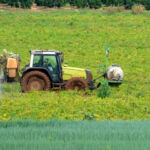Bioinsecticides are described as organic mixtures that are used to prevent the impact of insects on crops. According to the market database, bioinsecticides are a subset of biopesticides that are made up of natural elements to augment crop growth without harming the environment. Market research states that the natural elements that form these pesticides are sourced from plants, animals, bacteria, and some minerals. According to market research tools, over 6,000 species have been identified which possess insecticidal properties. Neem, custard apple, tobacco, etc. are a few of the plant resources that are used to develop bioinsecticides.
Market research suggests that they are available in different types such as macro, micro, and other types which include biorational and plant extract products. Bioinsecticides are used on crop types which are cereals, grains, oilseeds, pulses, fruits, vegetables, and others. According to the market database, improved quality, environment friendly, less risk to human health, little or no residuals, and targeted action are some of the significant advantages offered by bioinsecticides. The overall growth dynamics associated with this sector can be studied using Global Market Database. The market research platform helps the end-user analyze the upcoming trends for an industry vertical.
Classification Based on Form:
According to the market database, bioinsecticides are available in two distinct forms which include the dry form and the liquid form. Market research suggests that the dry forms are available in small pellets or dry powder form which can be applied on the surface of the plants, soil, and seeds. The market database also indicates that liquid bioinsecticides are preferred as they offer significant advantages such as low cost, can be easily mixed, longer shelf life, and easy to handle. The liquid bioinsecticides are further available in different forms such as water-based, oil-based, polymer-based, or any other combinations. Global Market Database can be used to study the overall industrial segmentation.
Analysis of Organism Type:
Market database suggests that the special properties of bioinsecticides are heavily dependent on the type of organism being used. According to market research tools, based on the organism type, the bioinsecticides market is divided as Bacillus Thuringiensis, Beauveria Bassiana, Verticillium Lecanii, Metarhizium anisopliae, and Baculovirus. Market database states that Bacillus Thuringiensis has commanded a greater share in the market. It is a species of bacteria that lives in the soil and generates a protein that is toxic for some insect breeds when consumed. The protein is not harmful to humans as it cannot be activated by mammalian cells. They are easy to produce and are cost-efficient which has established a positive market outlook for this type.
According to market research tools, Baculovirus is expected to be the fastest-growing in the market. This type has found significant applications in both outdoor and indoor farming environments. Baculovirus is an effective biocontrol agent that does not harm the health of applicators, generates no harmful impact on the environment, and leaves behind zero residual. Market research states that Baculovirus is available in liquid and is sprayed over a larger area to curb the spread of crop harming pests. Beauveria Bassiana is a type of fungus species that grows in the soil throughout the world. It is toxic for various insect species such as arthropods. The prominent growth segments for a given industry can be studied using Global Market Database. The cloud-based market research tool provides free market data across 600+ markets and 12 different industries.
Market database states that Verticillium lecanii or Lecancillium Lecanii is another fungal species that is used widely to control the action of pests. Metarhizium anisopliae or myco meta is a breed of fungus that is found in the soil throughout the world and is used in agricultural practices employing soil treatment methods.
Mode of Application:
According to the market database, bioinsecticides are available in dry and liquid forms, they are utilized in different ways to deliver the desired output. Market research states that this includes the use of methods such as foliar spray, seed treatment, soil treatment, and others. According to market research tools, the foliar spray method is defined as a technique of feeding plants by application of liquid bioinsecticides directly to the leaves. This method is used widely in different regions as it is easy to administer and involves less time. The overall revenue generated by this segment can also be studied using Global Market Database. The market research tool studies provide free market data for the first 5 GMD logins.
Market research suggests that in seed treatment techniques, the seeds of the crops are treated with the required material before immersed in the soil for production. Market database states that different target-specific bioinsecticides which are dependent on the type of crop are applied to the outer layers of the seeds. According to market research, such type of method has led to improved yield in several cases. Bioinsecticides can be used to treat the contaminated soil as well. This type of action is termed a soil treatment method and has helped to avoid the growth of weeds and pests in the first place.
Growth Catalysts of Bioinsecticides:
Market research suggests that the increased area under organic cultivation and concerns toward the impact of pesticide use on the environment has boosted the growth in this market. According to the market database, to adopt sustainable practices in the agricultural domain, wide-scale use of biopesticides is observed which has driven the use cases of bioinsecticides. Market research tools state that the role of Integrated Pest Management has played a significant role to drive business recovery in various farming frameworks. Supportive government policies to accomplish Sustainable Development Goals (SDG) have boosted the research capacity in this market. The growth dynamics for the agriculture module and the impact of norms as well as regulations can also be studied via Global Market Database. The Market penetration rate for organic farming technologies can also be assessed via market research tools.
The market showcased immunity towards the impact of COVID-19 induced pandemic. According to the market database, apart from the supply chain constraints, the market observed a robust demand for different farming activities across the world. The need for healthy food production methods has further accelerated the growth of bioinsecticides. The drivers, restraints, and challenges for this growth segment can also be studied through market research tools like Global Market Database.
According to the market database, the acceptance of new-age technologies such as agricultural drones and biogenetics have contributed towards an optimistic market outlook for bioinsecticides. Market research suggests that agricultural drones are integrated with sprayers of adequate capacity to avoid wastage of bioinsecticides and cover a large crop area. Pests usually generate resistance to certain bioinsecticides and newer forms can be formulated with the target-specific capability of biogenetics. Both traditional farming methods and indoor farming methods have witnessed the infestation of pests and require better quality bioinsecticides.
The U.S Market Perspective:
According to the market database, a well-established agricultural ecosystem along with major market players has resulted in the robust growth of bioinsecticides in this region. Market research suggests that the U.S is also a key exporter of fruits and vegetables and has incorporated sustainable food production methods. Greater consumer awareness towards chemical-free production methods has contributed towards an optimistic market outlook for this region. The country is also the base for next-generation start-ups that have started to integrate the use of deep technology to provide innovative solutions to agricultural problems.


